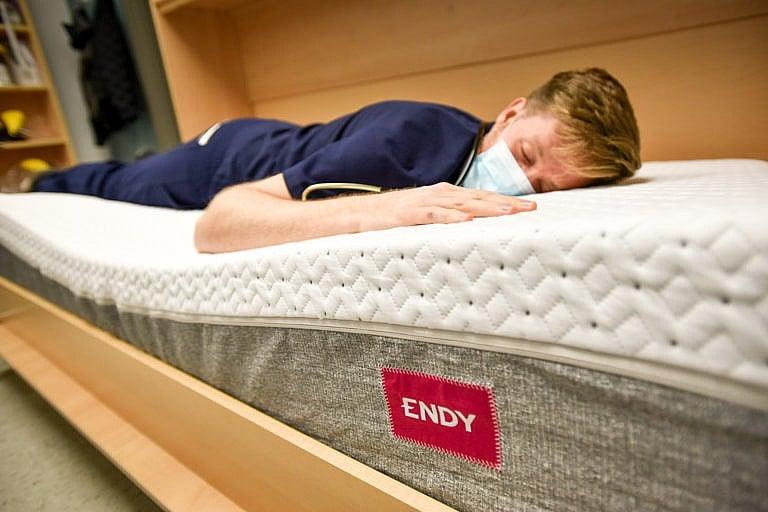Sleep scientists are working to offset the toll of night shifts and stress on healthcare workers
Healthcare workers are well familiar with the bodily toll of night shifts — but the additional complications of COVID, unprecedented stress and the interruption of normal routine are resulting in new levels of exhaustion

Share
Sleep is one of the many pillars of our health that has taken a big hit this past year. Between the stress of adjusting to at-home work, at-home school, endless lockdowns, financial uncertainty, distance from family and friends, and the worry of simply staying virus-free, our collective routines — those that typically act as benchmarks for our internal circadian clocks — have been completely upended. Anyone would lose sleep during a crisis of this magnitude, and in fact, we have. According to a first-of-its-kind study by Lin et al., conducted using a large sample of Chinese adults during the height of China’s COVID spread in early 2020, the pandemic has caused rates of insomnia, anxiety and depression to skyrocket among the general population.
Unsurprisingly, the psychological effects and rates of sleep deprivation among healthcare workers — those in COVID’s direct line of fire — were particularly exacerbated. That’s why Endy has prioritized their Healthcare Heroes initiative, which aims to improve quality of sleep for frontline healthcare workers by outfitting Call Rooms with donated mattresses.
Sleep loss (or disruption) is old hat for frontline medical workers, who are no strangers to night shifts. Still, Julie Carrier — a psychology professor at Université de Montréal and Director of the Canadian Sleep and Circadian Network — says the working conditions of healthcare professionals were a going concern for sleep researchers long before COVID hit.
“Our biological clocks send signals for us to get a good night’s sleep, and often, these workers’ [bodies] are in a constant state of imbalance,” says Carrier, who co-authored a review of Lin’s landmark research in the January 2021 edition of Sleep Med. “The chronic deprivation has major consequences for mood, anxiety, other health factors like cardiovascular disease and obesity, and can even increase the incidence of workplace accidents. We should, as a society, try to diminish this atypical working schedule as much as possible — but, of course, that’s not feasible in the health system.”
Carrier adds that, as is true of every other sphere of life, COVID has “only made things worse.” Not only are healthcare workers still beholden to rotating shift-work, but they are contending with the stressful onslaught of sick patients, and vulnerable to virus contraction themselves. “The good news is that scientists can do something to help out,” she says. The COVID test case has provided sleep researchers with ample opportunity to create public-health innovations that mitigate any long-term adverse effects — some of which are already underway.

While early sleep treatments typically relied on physical stimuli — the right lighting, the right mattress, the right amount of children crying (none) — cognitive-behavioural therapy now has a well-established track record of alleviating insomnia. But for time-strapped shift workers, visiting a therapist’s office for weekly hour-long sessions just isn’t doable. Thankfully, Carrier notes the emerging work of a colleague, Annie Vallière from Université Laval, who is pioneering a new CBT treatment that uses a digital interface — read: an app — to provide remote treatment, and whose progress is trackable by a supervising therapist. “We will need to do more research in order to make sure that it’s [scalable], to treat plenty of people at the same time,” says Carrier. “But the point is to provide healthcare workers with a restful sleep when they do sleep, as they are under a great deal of pressure right now.”
Dr. Andrew Latchman, Assistant Professor, Paediatrics at the McMaster Faculty of Health Services, has been working to fight fatigue with the McMaster healthcare system. “Fatigue is a common and unavoidable byproduct of the delivery of 24-hour care. However, learning from other high stakes 24/7 environments such as aviation and transportation, individual physicians and organizations are accepting and promoting fatigue risk management strategies, such as napping and maximizing sleep when working overnight or long shifts,” he explains. “Critical to the promotion of sleep is a comfortable and appropriate sleep space.”
When it comes to sleep strategies, the rise of telehealth solutions isn’t complete on its own. Carrier underscores the importance of broader, ongoing awareness campaigns for the general public to understand the true impact of sleep disorders — a condition that’s estimated to affect nearly a quarter of the Canadian population. (With plenty of stats and sleep hygiene tips, the Canadian Sleep and Circadian Network’s new initiative, Sleep On It, is a good online example.)
“Even if we’re only just starting these projects — and science and finding the right partners is a long process — we’ll know what we’ll need by summer or fall, when COVID [tapers off],” Carrier says, noting her optimism. But she’s under no illusion that the sleep loss incurred by already taxed medical frontliners during the pandemic will reverberate across society well into the future. “The impact of COVID-19 on sleep, especially in this population…” she says, “will stay for a long, long time.”
Endy has donated over 10,000 mattresses to charity, and with the new Healthcare Heroes initiative, they are doubling down on outfitting Canadian hospitals and frontline medical professionals with comfortable mattresses and bedding, so they can get the rest they deserve. Canadians are encouraged to nominate their local hospital for a call room transformation at endy.com/donations.
